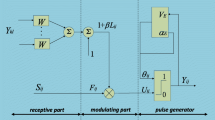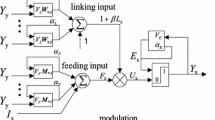Abstract
To address the issue of parameter settings in a pulse coupled neural network (PCNN), we propose a new image segmentation method based on the improved chicken swarm optimization algorithm and improved simplified PCNN (ICSO-ISPCNN) model. First, we improved a simplified PCNN model by modifying the dynamic threshold function and meanwhile improved the chicken swarm optimization (CSO) algorithm by introducing the survival of the fittest mechanism. Then, a product cross entropy is utilized as the fitness function of the ICSO algorithm, and the parameter values of the ISPCNN model are determined through the effective teamwork of roosters, hens, and chicks in the chicken swarm. Finally, we can achieve the automatic image segmentation via the ISPCNN model, which has the best parameter values. The detailed experiments indicate that our method has more superior performance in terms of convergence and segmentation accuracy than methods based on the genetic algorithm and ant colony optimization algorithm.















Similar content being viewed by others
References
Badrinarayanan V, Kendall A, Cipolla R (Jan. 2017) SegNet: a deep convolutional encoder-decoder architecture for scene segmentation. IEEE Trans Pattern Anal Mach Intell 39(12):2481–2495. https://doi.org/10.1109/TPAMI.2016.2644615
Chen YL, Ma YD, Kim DH, Park SK (2015) Region-based object recognition by color segmentation using a simplified PCNN. IEEE Transactions on neural networks and learning systems 26(8):1682–1697. https://doi.org/10.1109/TNNLS.2014.2351418
Chen YL, Park SK, Ma YD, Ala R (2011) A new automatic parameter setting method of a simplified PCNN for image segmentation. IEEE Trans Neural Netw 22(6):880–892. https://doi.org/10.1109/TNN.2011.2128880
Eckhorn R, Reitboeck HJ, Arndt M, Dicke P (1989) Models of brain function: a neural network for feature linking via synchronous activity: results from cat visual cortex and from simulations. Can J Microbiol 46(8):759–763
Ganesh M, Naresh M, Arvind C (2017) MRI brain image segmentation using enhanced adaptive fuzzy K-means algorithm. Intell Autom Soft Comput 23(2):325–330. https://doi.org/10.1080/10798587.2016.1231472
Gao C, Zhou DG, Guo YC (2013) Automatic iterative algorithm for image segmentation using a modified pulse-coupled neural network. Neurocomputing 119:332–338. https://doi.org/10.1016/j.neucom.2013.03.025
Gao C, Zhou DG, Guo YC (2014) An iterative Thresholding segmentation model using a modified pulse coupled neural network. Neural Process Lett 39(1):81–95. https://doi.org/10.1007/s11063-013-9291-z
Gómez W, Pereira WCA, Infantosi AFC (2016) Evolutionary pulse-coupled neural network for segmenting breast lesions on ultrasonography. Neurocomputing 175:877–888. https://doi.org/10.1016/j.neucom.2015.04.121
Gueguen L, Velasco-Forero S, Soille P (2014) Local mutual information for dissimilarity-based image segmentation. J Math Imaging Vis 48(3):625–644. https://doi.org/10.1007/s10851-013-0432-9
Jian MW, Lam KM, Dong JY et al (2015) Visual-patch-attention-aware saliency detection. IEEE Transactions on Cybernetics 45(8):1575–1586. https://doi.org/10.1109/tcyb.2014.2356200
Jian MW, Qi Q, Dong JY et al (2017) Saliency detection using quaternionic distance based weber local descriptor and level priors. Multimed Tools Appl 77(11):14343–14360. https://doi.org/10.1007/s11042-017-5032-z
Jian MW, Zhang WY, Yu H et al (2018) Saliency detection based on directional patches extraction and principal local color contrast. J Vis Commun Image Represent 57:1–11. https://doi.org/10.1016/j.jvcir.2018.10.008
Johnson JL, Mary LP (May 1999) PCNN models and applications. IEEE Trans Neural Netw 10(3):480–498. https://doi.org/10.1109/72.761706
Liang JH, Wang LF, Ma M, Zhang J (2018) A fast SAR image segmentation method based on improved chicken swarm optimization algorithm. Multimed Tools Appl:1–19. https://doi.org/10.1007/s11042-018-6119-x
Liao CZ, Zhang D, Jiang MY (2014) Image segmentation based on ABC-PCNN model. J Nanjing U Sci Techno 38(4):558–565
Lin YF, Wu LX (2018) Improved abrasive image segmentation method based on bit-plane and morphological reconstruction. Multimed Tools Appl:1–14. https://doi.org/10.1007/s11042-018-6687-9
Liu JP, Xu SH, Zhang FH et al (2016) A hybrid genetic-ant colony optimization algorithm for the optimal path selection. Intell Autom Soft Comput 23:1–8. https://doi.org/10.1080/10798587.2016.1196926
Ma YD, Dai RL, Li L (2002) Automated image segmentation using pulse coupled neural networks and image’s entropy. Journal of China Institute of Communications 23(1):46–51
Ma M, Liang JH, Guo M et al (2011) SAR image segmentation based on artificial bee Colony algorithm. Appl Soft Comput 11(8):5205–5214. https://doi.org/10.1016/j.asoc.2011.05.039
Ma YD, Liu Q, Qian ZB (2004) Automated image segmentation using improved PCNN model based on cross-entropy. Proceedings of 2004 International Symposium on Intelligent Multimedia, Video and Speech Processing, Hong Kong, pp 743–746
Ma YD, Shi F, Li L (2006) Study of automated PCNN system based on genetic algorithm. Journal of System Simulation 18(3):722–725. https://doi.org/10.3969/j.issn.1004-731X.2006.03.048
Martin D, Fowlkes C, Tal D, Malik J (2001) A database of human segmented natural images and its application to evaluating segmentation algorithms and measuring ecological statistics. Proceedings Eighth IEEE International Conference on Computer Vision, Vancouver, pp 416–423
Meilǎ M (2005) Comparing clusterings - an axiomatic view. Proceedings of the 22nd International Conference on Machine Learning, Bonn, pp 577–584
Meng XB, Liu Y, Gao XZ, Zhang HZ (2014) A new bio-inspired algorithm: chicken swarm optimization, vol 8794. Proceedings of the 5th International Conference on Swarm Intelligence, Hefei, pp 86–94
Oliva D, Hinojosa S, Cuevas E, Pajares G, Avalos O (2017) Cross entropy based thresholding for magnetic resonance brain images using crow search algorithm. Expert Syst Appl 79:164–180. https://doi.org/10.1016/j.eswa.2017.02.042
Oliva D, Hinojosa S, Osuna-Enciso V, Cuevas E, Pérez-Cisneros M, Sanchez-Ante G (2017) Image segmentation by minimum cross entropy using evolutionary methods. Soft Comput:1–20. https://doi.org/10.1007/s00500-017-2794-1
Pare S, Kumar A, Bajaj V, Singh GK (2017) An efficient method for multilevel color image thresholding using cuckoo search algorithm based on minimum cross entropy. Appl Soft Comput 61:570–592. https://doi.org/10.1016/j.asoc.2017.08.039
Qu SR, Yang HH (2015) Infrared image segmentation based on PCNN with genetic algorithm parameter optimization. High Power Laser Part Beams 27(5):38–43
Shih HC, Liu ER (2016) Automatic reference color selection for adaptive mathematical morphology and application in image segmentation. IEEE Trans Image Process 25(10):4665–4676. https://doi.org/10.1109/TIP.2016.2586658
Tian F, Zhang R, Lewandowski J, Chao K-M, Li L, Dong B (2017) Deadlock-free migration for virtual machine consolidation using chicken swarm optimization algorithm. J Intell Fuzzy Syst 32(2):1389–1400. https://doi.org/10.3233/JIFS-169136
Unnikrishnan R, Hebert M (2005) Measures of similarity. Seventh IEEE Workshops on Applications of Computer Vision, Breckenridge, pp 394–394
Wang Q, Gao JY, Li XL (2019) Weakly Supervised Adversarial Domain Adaptation for Semantic Segmentation in Urban Scenes. IEEE Trans Image Process:1. https://doi.org/10.1109/tip.2019.2910667
Wang Q, Gao JY, Yuan Y (2017) A Joint Convolutional Neural Networks and Context Transfer for Street Scenes Labeling. IEEE Trans Intell Transp Syst 99:1–14. https://doi.org/10.1109/TITS.2017.2726546
Wu YP, Peng XQ, Ruan K, Hu ZK (2017) Improved image segmentation method based on morphological reconstruction. Multimed Tools Appl 76(19):19781–19793. https://doi.org/10.1007/s11042-015-3192-2
Wu DH, Xu SP, Kong F (2016) Convergence analysis and improvement of the chicken swarm optimization algorithm. IEEE Access 4:9400–9412. https://doi.org/10.1109/ACCESS.2016.2604738
Xu XZ, Liang TM, Wang GY, Wang MX, Wang XS (2017) Self-adaptive PCNN based on the ACO algorithm and its application on medical image segmentation. Intell Autom Soft Comput 23(2):303–310. https://doi.org/10.1080/10798587.2016.1210258
Yu CQ, Wang JB, Peng C et al (2018) BiSeNet: Bilateral Segmentation Network for Real-time Semantic Segmentation. Proceedings of European Conference on Computer Vision:334–349. https://doi.org/10.1007/978-3-030-01261-8_20
Acknowledgments
This work is supported by Hainan Provincial Natural Science Foundation of China (618QN220), the Agricultural Science and Technology Innovation and Public Relations project of Shaanxi Province of China (2016NY-176), and the National Natural Science Foundation of China (61877038, 61373120).
Author information
Authors and Affiliations
Corresponding authors
Additional information
Publisher’s note
Springer Nature remains neutral with regard to jurisdictional claims in published maps and institutional affiliations.
Rights and permissions
About this article
Cite this article
Liang, J., Wang, L. & Ma, M. A new image segmentation method based on the ICSO-ISPCNN model. Multimed Tools Appl 79, 28131–28154 (2020). https://doi.org/10.1007/s11042-019-08596-9
Received:
Revised:
Accepted:
Published:
Issue Date:
DOI: https://doi.org/10.1007/s11042-019-08596-9




